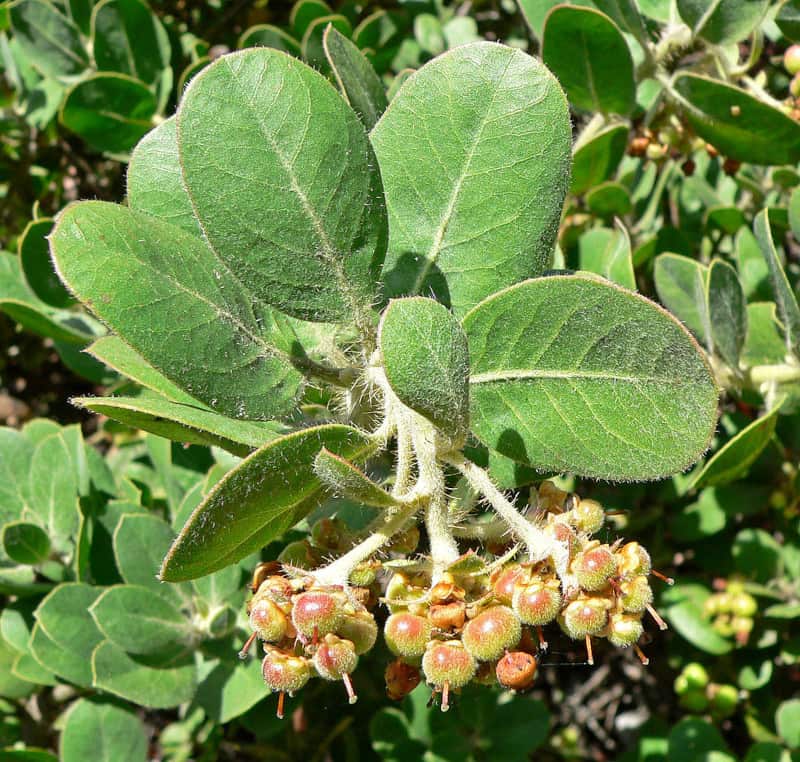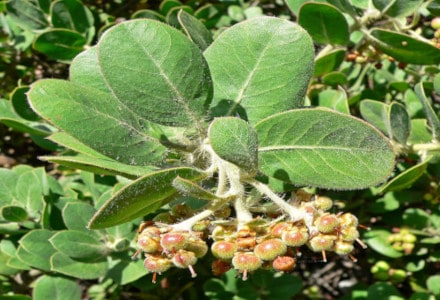
Santa Rosa Island Manzanita Facts
- This intriguing product of natural evolution most frequently goes by the common name of the Santa Rosa Island Manzanita. The name itself remains quite informative. Uncommonly, this remains the only routinely used non-technical name for the species.
- Among professionals, such as researchers, it’s more typically referred to by its official name. That, however, is an extremely difficult to pronounce term for most laymen. Tht’s because it’s burdened with the official moniker of Arctostaphylos confertiflora.
- Researchers first noted the plant in 1934. It owes this tongue-twisting name to the Canadian-American botanist, Alice Eastwood. She recorded the first recognition of it as a separate and distinct species. It joins numerous other species that she identified.
- Surprisingly, though, this tantalizing marvel of biology does not presently appear on the IUCN Red List of Threatened Species. That lack of classification surprises due to several factors. These include its native range and the number of known specimens.
- That’s all true due to the fact that the Santa Rosa Island Manzanita has a severely limited range. It also has a population that consists of only a few examples found in only two locations. It does, however, list as Imperiled in the country it appears in.
- Due to these conditions, it naturally faces multiple threats to its existence as a species. In the past, imported animals, such as pigs and cattle decimated its numbers. Presently, though, its limited population renders it especially vulnerable to climate change.
Related Articles
Santa Rosa Island Manzanita Physical Description
The gorgeous Santa Rosa Island Manzanita fascinates most of those fortunate enough to view it. It does so for a variety of reasons. Pure physical size, however, isn’t among those traits. That’s because it ranks as smaller than average among other varieties of manzanita.
This particular woody shrub develops as an evergreen. Most specimens display a strongly winding, twisting shape. Exceptional individuals reach heights measuring up to about 6 ft (1.8 m). Most examples, however, attain significantly shorter vertical measurements.
Individual stems branch often, and display an amazing color variety. That’s true given the fact that this part of the plant appears as any shade ranging from light gray to dark red. Each branch of the species also evelops a moderately dense covering of delicate white hairs.
The foliage of the very rare Angiosperm likewise has a covering of granular bristles. In color, these small leaves generally develop as a light green shade. These also most commonly show a dull shade, not waxy, like some related species of woody shrub present.
The flowers of the lovely Santa Rosa Island Manzanita also captivate the fortunate viewer. Although these remain extremely small in size, they make up for it in appearance. The blooms have a rounded shape, appear as milky white or pale pink, and grow in large clusters.
The fruits also possess distinctive qualities. These include being of a type known as a drupe. Each further remains extremely small, measuring an average of 0.4 in (1 cm) in diameter. Even this part of the Eudicot boasts a dense covering of fine hair-like structures.
- Kingdom: Plantae
- Phylum: Angiosperm
- Class: Eudicots
- Order: Ericales
- Family: Ericaceae
- Genus: Arctostaphylos
- Species: A. confertiflora
Santa Rosa Island Manzanita Distribution, Habitat, and Ecology
The magnificent flora that is the Santa Rosa Island Manzanita evolved as native to a region of the globe already renowned for its natural beauty. Not many people currently know of its existence, though, due to the specific limitations of that same range of habitation.
That’s partly due to the fact that it evolved as native to an isolated section of the United States, in North America. That location forms part of the state of California. It lives only on the island of Santa Rosa. That itself forms part of what’s now named the Channel Islands.
Even there, though, it only appears on the lone island of Santa Rosa, as the name implies. Researchers currently have no evidence that it ever appeared outside this range. There, though, the plant inhabits either conifer forests or regions of chaparal.
It further evolved as endemic to the precise conditions found within this micro environment. This predominantly consists of a combination of fairly wet winters and moderately dry summers. It also experiences regular disturbance by wildfires.
The very nature of its habitat limits the possibilities of the Santa Rosa Island Manzanita. The mainly sandstone composition of the underlying soil limits growth opportunities. Due to this, only two widely separated populations of the species remain on the island.
Experts still know surprisingly little about its life history. It’s known that it achieves pollination via the actions of several local insect varieties. These include the honeybee and bumblebee. Fortunately, numerous hummingbirds also assist in its pollination.
Species Sharing Its Range
Check out our other articles on Snowflake Moray, European Honey Buzzard, Villarrica, Snowshoe Hare, Army Geen Moth, Vietnamese Mossy Frog, Black Mamba

